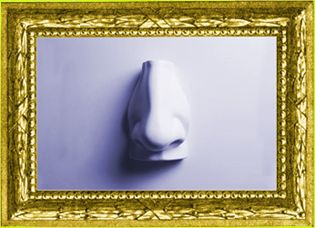
At last, a long-neglected sense has an exhibition space to call its own. Located a block off Park Avenue in midtown Manhattan, the Fragrance Museum (or, to use its full name, the Annette Green Galleries at the Fragrance Foundation) is the first museum in the country to be dedicated solely to smell.
My nose was running as I walked in during the opening week, but the receptionist was twice as snotty. "I'm sorry, but museum viewings are by appointment only." Directed to a shiny plastic chair in a waiting area of white tiled floors, fake plants, and mirrored pillars, I felt like I'd been relegated to the restroom of a two-star hotel. But instead of toilets there were gigantic perfume bottles on a counter. One square bottle with blue liquid, labeled "chrome," was larger than my torso. A couple of middle-aged industry suits were also there, waiting to hold court with Annette Green, the queen of the museum.
Green, who spearheaded the museum's development, has run the Fragrance Foundation for the last 40 years. It's a nonprofit organization that serves to promote the use of perfumes. She also founded the Olfactory Institute, an organization that funds research studies about the sense of smell. Named one of Mirabella's "1,000 most influential American women," Green is also something of a fragrance futurist. "I'm convinced we will have virtual reality fragrance cable boxes in our homes, where we can call up certain environments with the push of a button," she has said.
When the guard finally opened the door for me, I entered the upstairs gallery, a sort of high-security Macy's where all the perfume bottles (sometimes valued more than the scents they contained) were tucked away in rectangular glass cases. But no one, not even a cable box, was squirting me with samples. The inaugural exhibit 50 Years of Fragrance in America interweaves fashion with fragrance,grouping scents together according to decades, with a poster-sized signature image behind each case. A pair of Audrey Hepburn lookalikes wearing stylish hats of the era represented the '50s.
Scents included in the case: Miss Dior, Topaze, Memoire Chérie. For the '60s: A couple of go-go booted gals frolicking in a nature scene. Exquisite, Zen, Imprévu. For the '70s: Two Studio 54-esque strumpets posing with flowers in their hair. Charlie, Enjoli, Jovan Musk, Halston. In the '80s: Big-haired babes lying on an opulent banquet table. Eternity, Poison, Must de Cartier. And for the '90s: Two supermodels looking bored. Green Tea, Clinique Happy, Vanilla Fields.
Annette Green's galleries trace a history redolent with the scent of growing cash. Starting in the '60s, the French perfumeries were sold out to U.S. petrochemical and pharmaceutical giants, while clothing designers and high-end retailers jumped into the game in the '70s. But perfumes couldn't have become a $6 billion industry without the success of television advertising. This is underscored by the video Seeing Scents, where a seemingly endless loop of perfume commercials played without comment in an adjoining viewing room.
I swallowed a 20-minute dose of ads from the '80s and '90s, filling my head with the stench of overpaid models and slick platitudes: "All things are possible." "How far you go is up to you." "Indian Summer: the new perfume by Priscilla Presley." "Beauty that dims the moon: Black Pearls." "Gravity: You couldn't resist if you tried." Thankfully, the familiar ding-dong of the Avon bell knocked me out of the TV trance. I felt like I needed a shower, but instead opted for a few sniffs at the adjacent "Smelling Scenter."
A counter was set up with most popular fragrance notes of the decades, with little sticks that could be dipped into the various scents. I took a few pleasant whiffs of "jasmine," "sandalwood," and "chocolate," but when I dipped into the bottle labeled "leather" I came into my own. Suddenly I was transported into the pervy world of Frank Booth in Blue Velvet, a land of ripped car seats, divey bars, and cracking whips. Here was a scent I could sink my teeth into.
Lex Lonehood lives in New York and writes for Citytripping.com and Art Bell's "After Dark."
